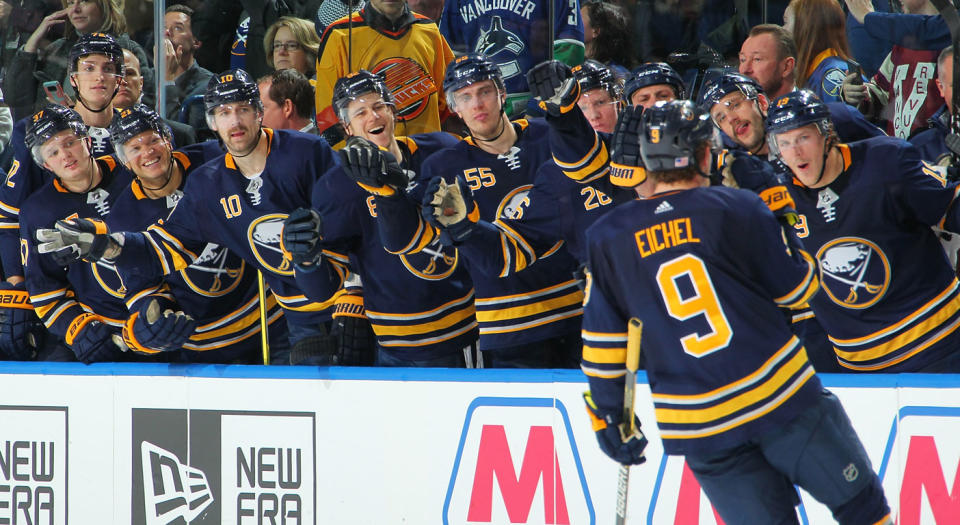What's driving the Buffalo Sabres' unexpected results?
With the Penguins up 4-1 on the Sabres on home ice Monday, order, it seemed, was in the beginning stages of being restored in the NHL’s Eastern Conference.
Instead Buffalo answered with three to tie in regulation before Jack Eichel won it for the Sabres in overtime, widening the rather head-scratching gap between two franchises that have operated at opposite ends of the conference for the last decade or so.
More losses like these will bring on more and more skepticism about the Penguins and if their inevitable decline has indeed arrived. But for me, the more intriguing detail from the result, and the Sabres’ form, is the question: Are these guys for real, for real?
Now with 28 points from 21 games, the Sabres are two points out of first place in the most competitive division in hockey and have the fourth-most points in the entire NHL. They’ve won six in a row, beating playoff teams in each of those games before passing the Pittsburgh test.
A deeper dive into the numbers reveals that the Sabres aren’t wildly outperforming their shot-based measures, but there are elements of fortune here, too.
Essentially trading shots at even rate with the opposition at the quarter mark of the season (which is a marked improvement given their most recent historical measures), the Sabres rank 18th in scoring with three goals a game, while holding the ninth-best goals against mark with 2.86 allowed on average. Helping support those numbers, Buffalo’s power play is performing in the bottom third of the NHL while its penalty kill has shone, ranking sixth in the league.
All told, the Sabres have a modest plus-goal differential both at 5-on-5 and overall, which is in line with a team that owns a 50 percent shot share, but maybe not one that’s accumulated points with the elite teams.
So how have the Sabres squeezed the absolute most from their current form?
An elite unit
More and more, it seems we are seeing coaches load up their top line in lieu of spacing their talent across multiple scoring units.
With Jason Pominville providing the veteran “glue” on a top line that features a legitimate superstar and an offensive wiz in Eichel and Jeff Skinner, respectively, the Sabres might not be the team that best represents this top-heavy strategy, but their No. 1 unit is producing with, or above, the league’s most talented top lines anyway.
Plus-nine in even-strength goal differential and fourth among units up over 100 minutes in shot-attempt share, the numbers would argue that only the Colorado Avalanche’s absurdly productive top line of Nathan MacKinnon, Mikko Rantanen and Gabriel Landeskog have been more effective to this point.

Eichel is the obvious driving force here, but Skinner’s impact shouldn’t be understated. He’s up to 14 goals and counting better than a point per game while also tied with Landeskog and John Tavares for the top individual on-ice goal differential at evens.
With lines two-through-four, being able to break even or better is invariably the key for teams that opt to saturate their skill within a single unit. For his part, head coach Phil Housley deserves credit for making this happen by continuously moving the parts around in an effort to find a winning combination — and it appears that he’s uncovering segments of it.
Versus Pittsburgh leaning most on the two pairings that have driven the best results this season — Rasmus Ristolainen with Jake McCabe and Rasmus Dahlin with Zach Bogosian — it’s clear that Housley isn’t waiting for results, he’s pursuing them.
High-leverage goaltending
Exceeding expectations to this point, Buffalo’s tandem of Carter Hutton and Linus Ullmark has been critical to the Sabres’ success. Hutton, a converted backup acquired in free agency, is adjusting nicely to an increased workload with a .917 save clip, while the returning Ullmark hasn’t yet lost in regulation behind a .922 mark.
Given their individual contributions, it is somewhat surprising then to learn that just 10 teams have allowed more goals at even strength. That team rank vastly improves, though, when you lump in the remaining scenarios, and in particular the penalty kill. Hutton and Ullmark are powering the NHL’s sixth-ranked kill with an 89.5 percent combined saved clip.
Recognizing that Buffalo has drastically cut down on the time spent killing penalties, and it, as much as anything, explains how the Sabres have delivered huge results from their solid start to the season.
More NHL coverage on Yahoo Sports:



